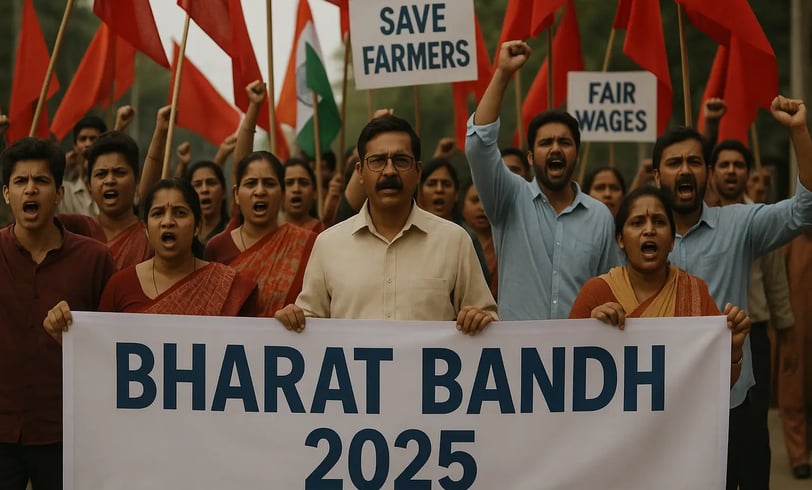What is Bharat Bandh 2025? Meaning, History, Causes & Impact.
Discover the significance of Bharat Bandh 2025. Learn why it's happening, who’s involved, historical context, and how it affects daily life and the economy.


Bharat Bandh 9-7-2025: Meaning, History, Current Reasons & Impact on India
🛑 What is Bharat Bandh?
Bharat Bandh, meaning “India Closed,” refers to a nationwide strike organized to protest against government policies, social injustices, or labor reforms. It is one of India’s most powerful forms of civil resistance, uniting trade unions, political parties, farmers’ groups, and activist organizations to demand change. It is scheduled for Wednesday, 9 July 2025, starting early morning and lasting the entire day. More than 25 crore (250 million) workers from formal and informal sectors.
These strikes are typically announced through media channels, public demonstrations, and social media campaigns, and are marked by the closure of businesses, suspension of transportation, and mass mobilization across the country.
📜 Historical Background of Bharat Bandh
The concept of Bharat Bandh has its roots in India’s freedom struggle, where mass shutdowns were used to protest colonial policies. After independence, the practice evolved as a tool for political and economic resistance.
Notable Bharat Bandh Events:
1988: Trade unions protested against labor law changes and privatization.
2016: Farmers called a nationwide bandh demanding better crop prices and loan waivers.
2020: Massive protests erupted against the controversial farm laws, uniting farmers and laborers alike.
These events illustrate Bharat Bandh as a deeply entrenched democratic mechanism in India, often triggering national conversations and policy revisions.
🔥 Why is Bharat Bandh Happening in 2025?
The Bharat Bandh scheduled for July 9, 2025, is being supported by over 25 crore workers, making it one of the largest general strikes in recent history. A united front of 10 central trade unions—including AITUC, INTUC, CITU, HMS, AICCTU, TUCC, AIUTUC, SEWA, LPF, and UTUC etc. The following are the key issues driving the protest:
1. 🧑🏭 Labor Rights
Demand for rollback of the four labor codes passed by the government.
Protest against job casualization, outsourcing, and lack of social security.
2. 🌾 Farmers’ Demands
Fair Minimum Support Prices (MSP) for crops.
Compensation for crop losses and opposition to pro-corporate agricultural laws.
3. 💸 Inflation & Economic Inequality
Protest against rising fuel and food prices.
Demand for wage hikes and pension security.
4. 🌍 Environmental & Social Justice
Criticism of industrial projects affecting the environment.
Marginalized groups demanding better representation and protection of rights.
🧑⚖️ Political Response to Bharat Bandh
Bharat Bandh often divides political opinion:
Opposition parties tend to support the bandh, using it as an opportunity to amplify public dissent.
Ruling parties usually condemn it, labeling it politically motivated.
Law enforcement agencies often ramp up security, especially in protest hotspots, to prevent violence or unrest.
The public reaction plays a crucial role in shaping the narrative—either pushing the government toward negotiation or hardening resistance.
🏙️ Impact of Bharat Bandh on Daily Life
A nationwide strike like Bharat Bandh has tangible effects on everyday life:
✈️ Transportation:
Bus and train services often disrupted or suspended.
Roads may be blocked by protestors, causing massive traffic delays.
🏪 Businesses:
Shops, markets, and banks shut down in several cities.
Daily wage workers lose income, severely impacting low-income families.
🏥 Public Services:
Delays in emergency medical services, postal delivery, and school closures.
Government offices operate with limited staff or remain closed.
📊 Economic Consequences of Bharat Bandh
The economic fallout from Bharat Bandh can be substantial:
SMEs (Small and Medium Enterprises) face loss of revenue and operational delays.
Daily wage earners and contract workers lose crucial income.
Productivity dips, and consumer spending declines, causing ripple effects across industries.
Frequent strikes also impact foreign investor confidence and overall economic sentiment.
🗣️ Public Sentiment and Digital Mobilization
Public support varies based on region and cause:
Students and youth groups often support the bandh for causes related to education, employment, or justice.
Urban populations may view it as disruptive but necessary, while rural populations may struggle to participate due to livelihood constraints.
Role of Social Media:
Hashtags like #BharatBandh2025 trend on platforms like Twitter and Instagram.
Online campaigns help organize support, spread awareness, and document protest activities in real time.
🔮 The Future of Bharat Bandh in Indian Democracy
Bharat Bandh continues to be a symbol of collective resistance and democratic action. As civic awareness grows and digital tools empower grassroots movements, we can expect such protests to become even more sophisticated and far-reaching.
Key Takeaways:
Bharat Bandh 2025 highlights India’s unresolved socio-economic challenges.
It acts as a wake-up call for policymakers, signaling the urgent need for inclusive dialogue.
Future Bharat Bandhs will likely continue evolving as tools for policy pressure and social reform.
